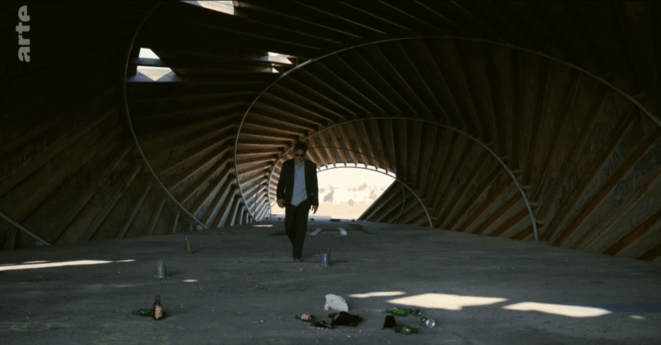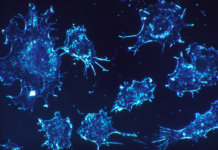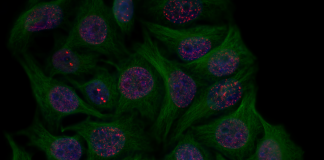Arte Series—Ad Vitam, transhumanism, immortality: what if it were possible?
A world where immortality is possible: that is the transhumanist setting of the series Ad Vitam, on Arte TV. Directed by Thomas Cailley and starring Yvan Attal and Garance Marillier, its 6 episodes were broadcast in France on the Arte channel, and streamed on the Arte website at the end of 2018.
The series follows a police investigation; in a world where death has almost disappeared, there are a handful of suicidal teenagers. The act revolts and distresses people, and Darius, a 119-year-old inspector in charge of investigating a similar affair ten years earlier, is assigned to the investigation. To find the terrorists behind these suicides, he will bring Christa, a 24-year-old survivor of the mass suicide he investigated, out of her internment.

Ad Vitam on Arte: a society without aging
You expected a series on immortality that deals with life? We are here in a world of dystopia; to compose the story, we start from scientific elements (the possibility of destroying aging, seriously considered by present-day transhumanism) to draw a fiction that will explore the limits of the concept.

Thus, rather than discussing life, Ad Vitam addresses death, and its treatment echoes with what death has become in our societies where the average life expectancy is 80 years: we are less and less confronted with it on a daily basis. In the series, it also extends to frailty and weakness—the characters can immerse themselves in a regenerating bath to regain the health of their 30s at will. No more old age, no more diseases, now all that remains is to explore humanity’s reaction to this new reality.
For if in science fiction, science is a pretext for fiction, in Ad Vitam it is to tell us about the meaning of existence. Thus, everything in the world of the series revolves around this regeneration which was nevertheless set up a century earlier and whose central place in the life of society has nothing to envy to that of vaccines or antibiotics.
Ad Vitam on Arte: a transhumanist setting
Since it is a fiction, it focuses on romanticizing the plot, rather than exploring the interactions between interdependent subjects. The background of the series barely hints at the question of ecology, economics and politics in a world where everyone can stay young. The country, which is not named, seems to have closed its borders, all citizens live in a certain level of material comfort, and the issue of overcrowding only arises when it comes to controlling births and sharing the territory—cemeteries are being leveled and a few uninhabited islets are on the way out.
These inconsistencies, which can be likened to scenario shortcuts, allow us to focus on the central question underlying the series: what is a life without death?
Ad vitam on Arte: immortality… or amortality?
Immortality is not to be confused with amortality, people still die, especially from accidents, but the existence of this choice divides society in two: on the one hand, those who resort to regeneration and can live as long as they wish, to the point of forgetting that it could stop; the police station corridors are haunted by a man, an angel of death, whose job is to announce deaths to relatives who have difficulty understanding this idea.
On the other hand, a rebel fringe of society that does not want (or cannot, especially because of poor health in their early years) to resort to regeneration. These people fascinate, they age, they repel. They are accompanied at the time of their death, and celebrate deaths with great feasts. They form a cult, because aging is no longer socially acceptable.


No one understands that they can choose old age and its evils, so they are the first suspects in the anti-terrorist investigation that seeks to stop youth suicides. We can regret a Manichean treatment of these characters, who celebrate life and are therefore the pariahs of society, and that the scenario strives to make sympathetic. Is that enough to identify with them?
Ad Vitam on Arte: what place for youth in the absence of aging?

What the series likes to explore is the place of young people in a society where we do not age, because young people grow up. The age of majority has been raised to 30 years, because it is the age at which the body becomes mature enough to handle the regeneration process. However, this traditionally anti-establishment youth is full of resentment that they are still labeled immature, “underage” for what seems like an eternity, and as time goes by, the gap widens between regenerated people who are over a century old, and a vibrant youth whose perspective is radically opposed to that of the elders. Adults are moving away from these eternal children whom they no longer understand, while young people are reluctant to join the ranks of a society that does not want them. Here too, without too much subtlety, we can read the crystallization of a problem that already affects our societies but that the series only observes and exploits, rather than solves.
The essential question remains: what is living? How do we live without an expiry date to give value to our existence? In Ad Vitam, the characters thus take several jobs one after the other, several marriages, several lives, with the help of career transition coaches. Most of them seem to be disconnected from reality. Either they have accommodated to a repetitive existence, or they are in search of meaning, a meaning they sometimes seek through parenthood, with mixed results.

Ad Vitam and the issue with immortality
Anticipatory fictions confront us with the potential problems of the future. They allow us to be better prepared for it. Rather than looking at these fictions as prophecies, we can see opportunities for reflection to develop the best possible systems.
Immortality and overpopulation
This is particularly the case for the issue of overcrowding. If this pitfall comes to mind first, it is because this challenge is no longer part of our distant future: it has been an integral part of our present for several decades. The average lifespan increased during the 20th century across the globe, and our societies are confronted with problems of overpopulation. However, when we study the age pyramid* in the various countries of the world, we see a phenomenon of self-regulation: healthier populations, those who live longer, have fewer children, for reasons that can be assumed to be sociocultural (longer studies, better access to contraception and health information, less need to rely on the financial assistance of their children once they retire…)
*age pyramid: https://www.worldlifeexpectancy.com/country-health-profile/united-states

Today, a gap remains between developed and developing countries, but there is every reason to believe that once industrialized, the countries that are currently catching up with the West (as India will soon have) in terms of technology will adopt the same societal practices, which would lead to a general decline in births and could help to regulate the population.
Immortality and vegetarianism
This phenomenon has already been observed in Europe with meat consumption. Meat, once very rare at the table, has become an external sign of wealth and a pillar of our diet since the beginning of the industrial era. However, in the face of the ecological challenges posed by intensive livestock farming and changing lifestyles (there is less need for quick animal protein intake when you spend your day sitting in an office), European societies are gradually moving towards a diet that is lower in animal products, and are turning towards alternatives: in short, we are adapting our lifestyles to our societies.
Because with the extension of life in good health, to maintain the balance of society, the whole issue lies in adapting everyone’s lifestyle in order to guarantee a stable and strong society.
Immortality, economics and work
A radically longer life for the whole population would therefore require a partial rethinking of the organisation of our societies. This would be the case with work organization: what price is given to a life?
Is it more valuable because it is longer and we are trying to waste it less, to enjoy it more? Or would we be willing to accept longer periods of servitude as is the case today, with the extension of the retirement age—and if we stay healthy, when do we take the time to live rather than work?
For those who succeed in their work, it is also the opportunity to continue to perfect themselves, and thus, the most brilliant elements of society could continue to share their discoveries, their inventions, their art.
Would we adapt working time to enjoy our lives? Would we use the technology that will then be at our disposal to relieve ourselves of the unpleasant tasks, and create value and time that everyone can then reinvest in order to flourish in the long life that awaits them?

Immortality and the environment
What about the ecological transition? With the climate change we are experiencing, a longer life expectancy could raise awareness of the environmental challenges faced by humanity for those who do not feel affected by the issue; perhaps we would see a greater enthusiasm to take care of the resources that allow humanity to exist.

Ad Vitam on Arte, a good French TV show
These changes will not happen all at once; as with the decline in the birth rate in rich countries, they will be gradual, and it will be up to the whole society to decide.
It is a shame that Ad Vitam is only scratching the surface of these questions; with its captivating universe and very good casting, this series had the potential to explore in depth the question of extending life expectancy and its concrete impacts on society. It remains a work of science fiction, a dystopia that does not go into anticipation or into the possible docu-fiction.
Nevertheless, its striking atmosphere is worth it, and while waiting for the future where we will finally have the possibility to live as long as we want, Ad Vitam remains a good French series to binge watch on cold winter nights.
Dr Guilhem Velvé Casquillas

Author/Reviewer
Auteur/Relecteur
Physics PhD, CEO NBIC Valley, CEO Long Long Life, CEO Elvesys Microfluidic Innovation Center
More about the Long Long Life team
Docteur en physique, CEO NBIC Valley, CEO Long Long Life, CEO Elvesys Microfluidic Innovation Center
En savoir plus sur l’équipe de Long Long Life



![[Video] Eurosymposium on Healthy Ageing, Brussels, 2018 Eurosymposium on Healthy Aging](https://www.longlonglife.org/wp-content/uploads/2019/07/P1310252-218x150.jpg)










